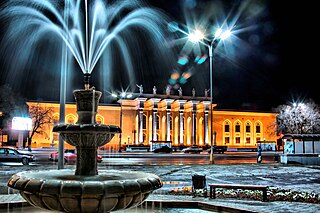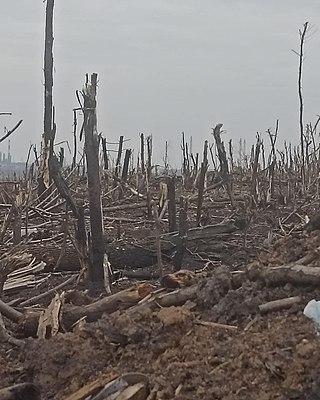Related Research Articles

Amazonite, also known as amazonstone, is a green tectosilicate mineral, a variety of the potassium feldspar called microcline. Its chemical formula is KAlSi3O8, which is polymorphic to orthoclase.

A land mine, or landmine, is an explosive weapon concealed under or camouflaged on the ground, and designed to destroy or disable enemy targets, ranging from combatants to vehicles and tanks, as they pass over or near it.

A naval mine is a self-contained explosive device placed in water to damage or destroy surface ships or submarines. Similar to anti-personnel and other land mines, and unlike purpose launched naval depth charges, they are deposited and left to wait until, depending on their fusing, they are triggered by the approach of or contact with any vessel.

Potash includes various mined and manufactured salts that contain potassium in water-soluble form. The name derives from pot ash, plant ashes or wood ash soaked in water in a pot, the primary means of manufacturing potash before the Industrial Era. The word potassium is derived from potash.

The carbon group is a periodic table group consisting of carbon (C), silicon (Si), germanium (Ge), tin (Sn), lead (Pb), and flerovium (Fl). It lies within the p-block.

Primorsky Krai, informally known as Primorye, is a federal subject of Russia, part of the Far Eastern Federal District in the Russian Far East. The city of Vladivostok on the southern coast of the krai is its administrative center, and the second largest city in the Russian Far East, behind Khabarovsk in the neighbouring krai. Primorsky Krai has the largest economy among the federal subjects in the Russian Far East, and a population of 1,845,165 as of the 2021 Census.

Coal mining is the process of extracting coal from the ground or from a mine. Coal is valued for its energy content and since the 1880s has been widely used to generate electricity. Steel and cement industries use coal as a fuel for extraction of iron from iron ore and for cement production. In the United Kingdom and South Africa, a coal mine and its structures are a colliery, a coal mine is called a "pit", and above-ground mining structures are referred to as a "pit head". In Australia, "colliery" generally refers to an underground coal mine.

Karaganda, also known as Karagandy, is the capital of Karaganda Region, Kazakhstan. It is the fifth most populous city in Kazakhstan, behind Almaty (Alma-Ata), Astana, Shymkent and Aktobe. The city has a population of 497,777 as of the 2020 Census results; up from 459,778 ; up from 436,864. Karaganda is approximately 230 km (140 mi) southeast of Kazakhstan's capital city of Astana.

Moritz Hermann von Jacobi, russified from 1837 as Boris SemyonovichYakobi was a Prussian and Russian Imperial engineer and physicist of Jewish descent. Jacobi worked mainly in the Russian Empire. He furthered progress in galvanoplastics, electric motors, and wire telegraphy.

The Karzełek or Skarbnyk, Kladenets or Dzedka in Slavic mythology live in mines and underground workings and are the guardians of gems, crystals, and precious metals. It is said that they will protect miners from danger and lead them back when they are lost. They will also lead them to veins of ore. To people who are evil or insult them they are deadly, pushing them into dark chasms or send tunnels crashing down upon them. Hurling rocks, whistling, or covering one's head are actions that are offensive to Skarbnik, who will warn the offender with handfuls of pelted soil in their direction before taking serious action.

Lebap Region is one of the regions of Turkmenistan. It is in the northeast of the country, bordering Afghanistan, Uzbekistan along the Amu Darya. Its administrative centre is Türkmenabat. It has an area of 93,727 square kilometers, and a population of 1,447,298 people.

Dalnegorsk is a town in Primorsky Krai, Russia. Population: 37,519 (2010 Census); 40,069 (2002 Census); 49,792 (1989 Soviet census).

Berezniki is the second-largest city in Perm Krai, Russia. The city is located on the banks of the Kama River, in the Ural Mountains with a population of 135,533 as of 2023.

The Southeast Missouri Lead District, commonly called the Lead Belt, is a lead mining district in the southeastern part of Missouri. Counties in the Lead Belt include Saint Francois, Crawford, Dent, Iron, Madison, Reynolds, and Washington. This mining district is the most important and critical lead producer in the United States.

An anti-personnel mine or anti-personnel landmine (APL) is a form of mine designed for use against humans, as opposed to an anti-tank mine, which target vehicles. APLs are classified into: blast mines and fragmentation mines; the latter may or may not be a bounding mine.
The mineral industry of Russia is one of the world's leading mineral industries and accounts for a large percentage of the Commonwealth of Independent States' production of a range of mineral products, including metals, industrial minerals, and mineral fuels. In 2005, Russia ranked among the leading world producers or was a significant producer of a vast range of mineral commodities, including aluminum, arsenic, cement, copper, magnesium compounds and metals, nitrogen, palladium, silicon, nickel and vanadium.
Kan-i-Gut cave is a geological protected area located at north slopes of Turkestan Range in Batken District, Batken Region, Kyrgyzstan. The cave consists of 18 large caverns, deep cavities, narrow passageways and tunnels. It is 6,000 metres (20,000 ft) long and 100 metres (330 ft) deep. From the 6th to the 11th century the cave served as a lead and iron mine. Silver and other metals and minerals were also mined here at the time. The first miners in the cave were Arabs, so the Chinese continued, and much later during World War II, Soviet political prisoners mined here.
The natural resources of the Arctic are the mineral and animal natural resources which provide or have potential to provide utility or economic benefit to humans. The Arctic contains significant amounts of minerals, boreal forests, marine life, and fresh water.

The mining industry of Sudan is mostly driven by extraction fuel minerals, including gold. Prior to becoming independent in 2011 as South Sudan, petroleum extraction in the autonomous region of Southern Sudan accounted for a substantial contribution to the country's economy. Following South Sudan's independence, growth in the gold mining industry saw substantial traction. By 2022, Sudan would emerge as the third-largest producer of gold in Africa.

The Russian invasion of Ukraine has led to ongoing widespread and possibly serious and long-term environmental damage. The Ukrainian government, journalists and international observers describe the damage as ecocide.
References
- 1 2 3 "East West transport corridor" (PDF). ewtc2.eu. 2012. Retrieved 2013-07-09.